Abstract
Many biological proteins are observed to fold into one of a limited number of structural motifs. By considering the requirements imposed on proteins by their need to fold rapidly, and the ease with which such requirements can be fulfilled as a function of the native structure, we can explain why certain structures are repeatedly observed among proteins with negligible sequence similarity. This work has implications for the understanding of protein sequence structure relationships as well as protein evolution.
Full text
PDF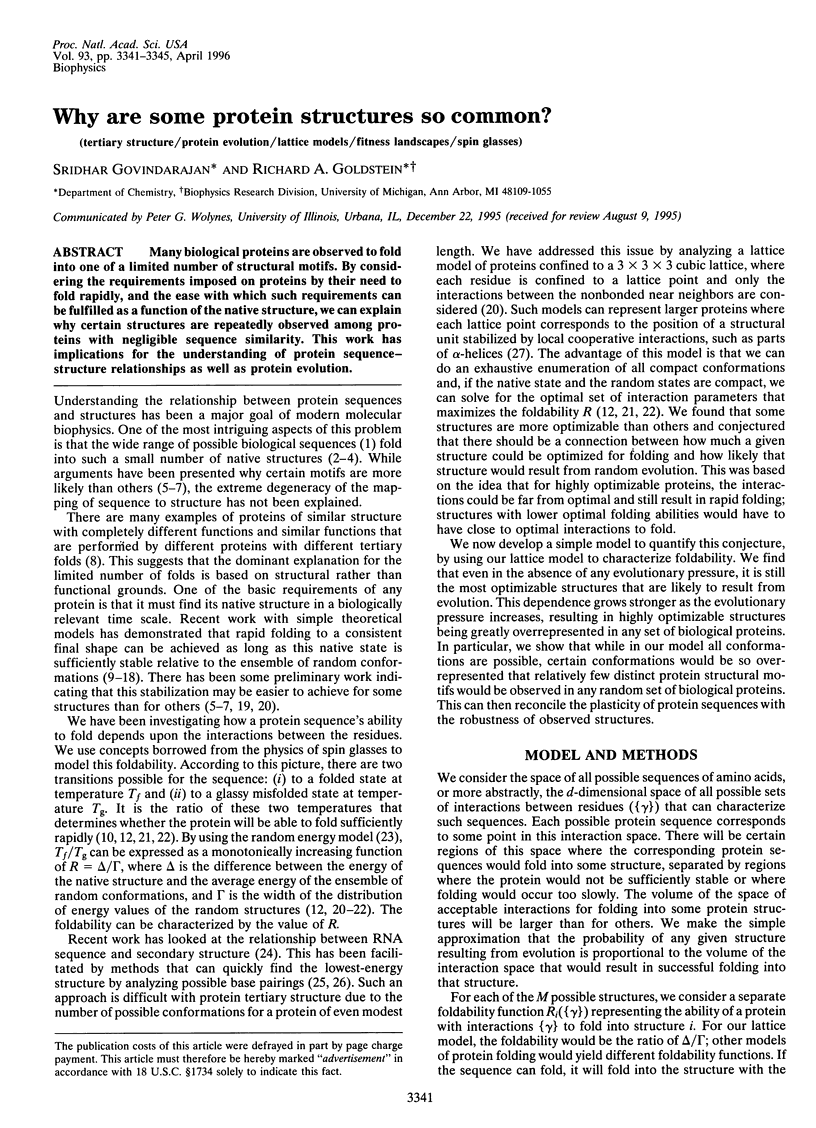
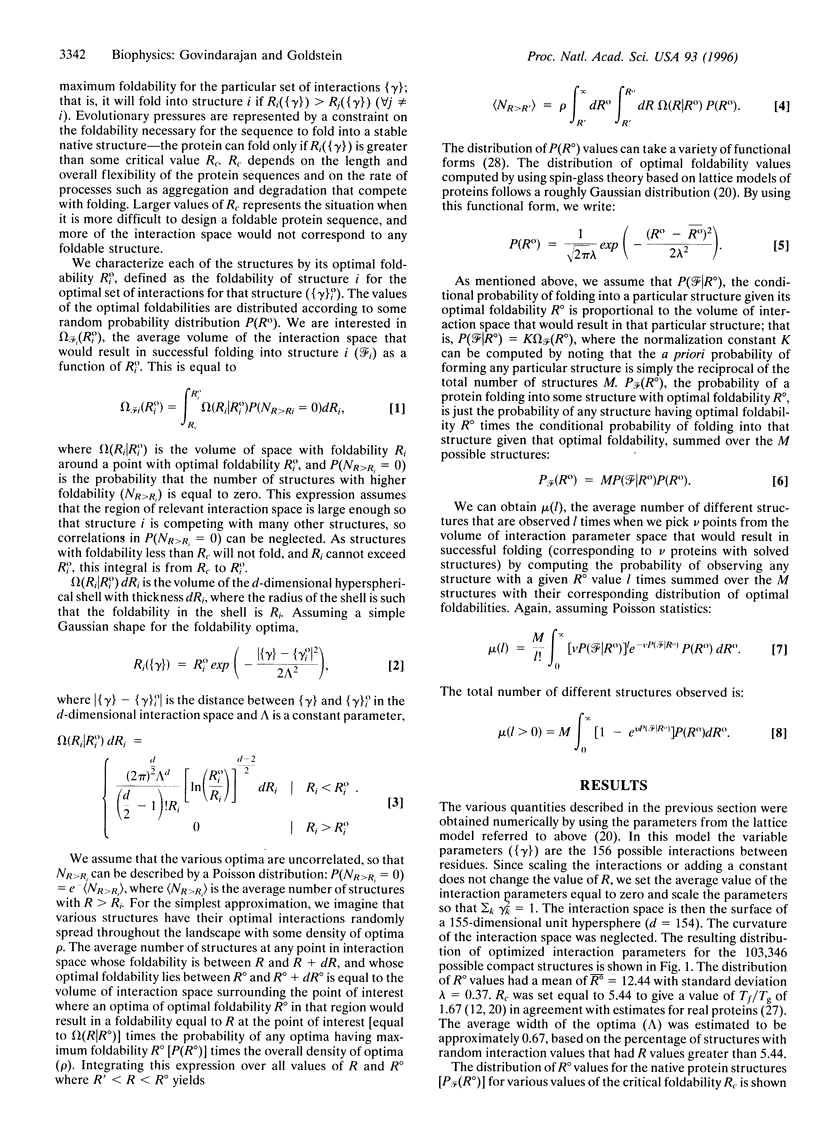
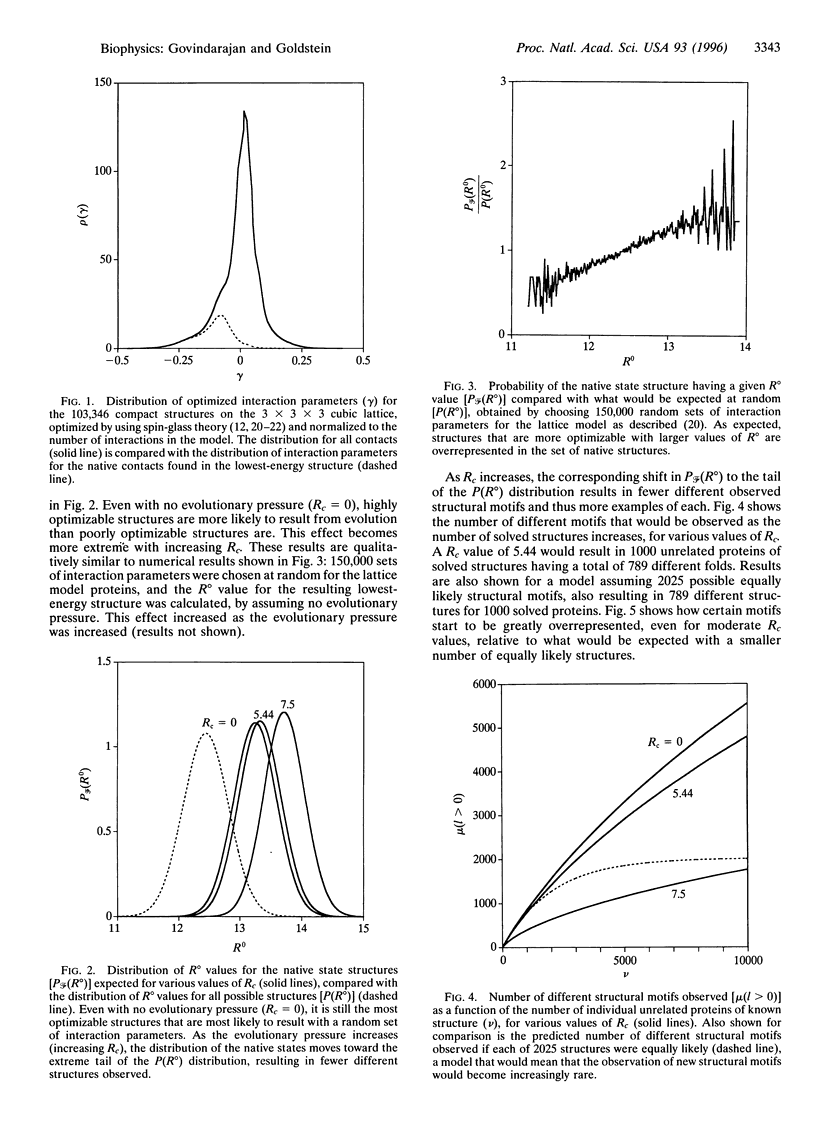
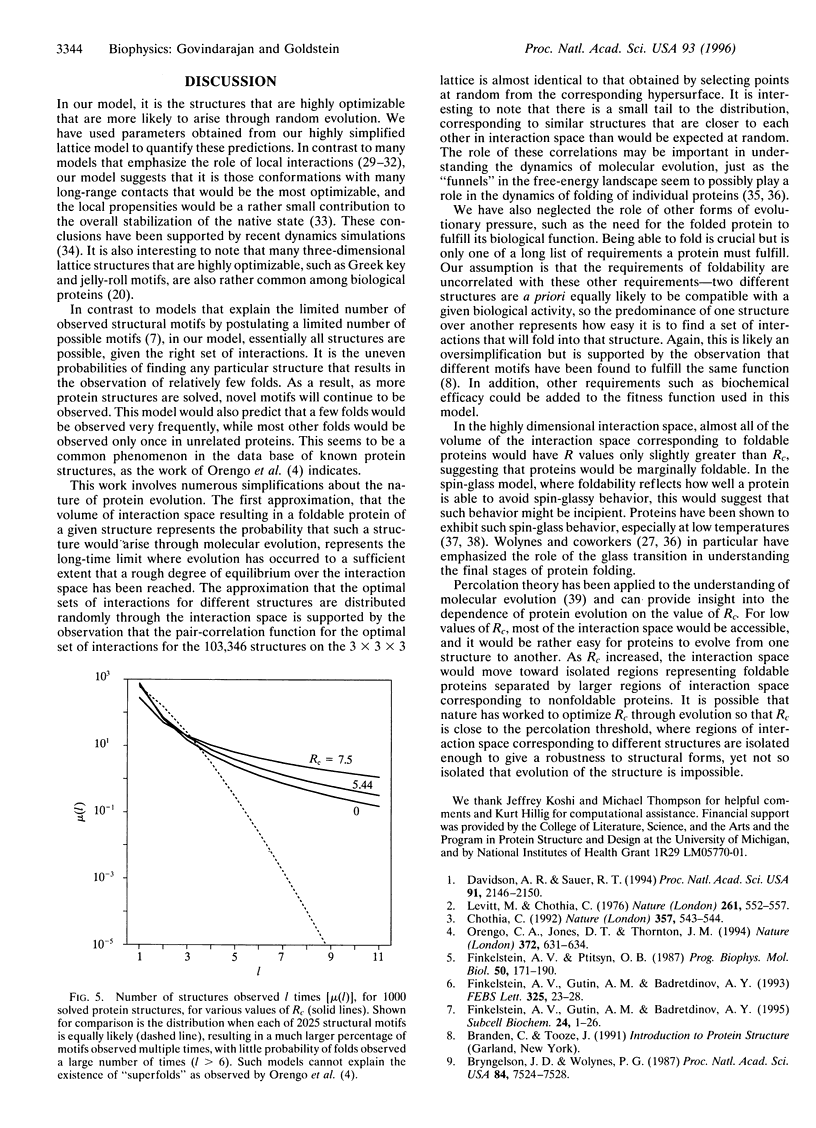
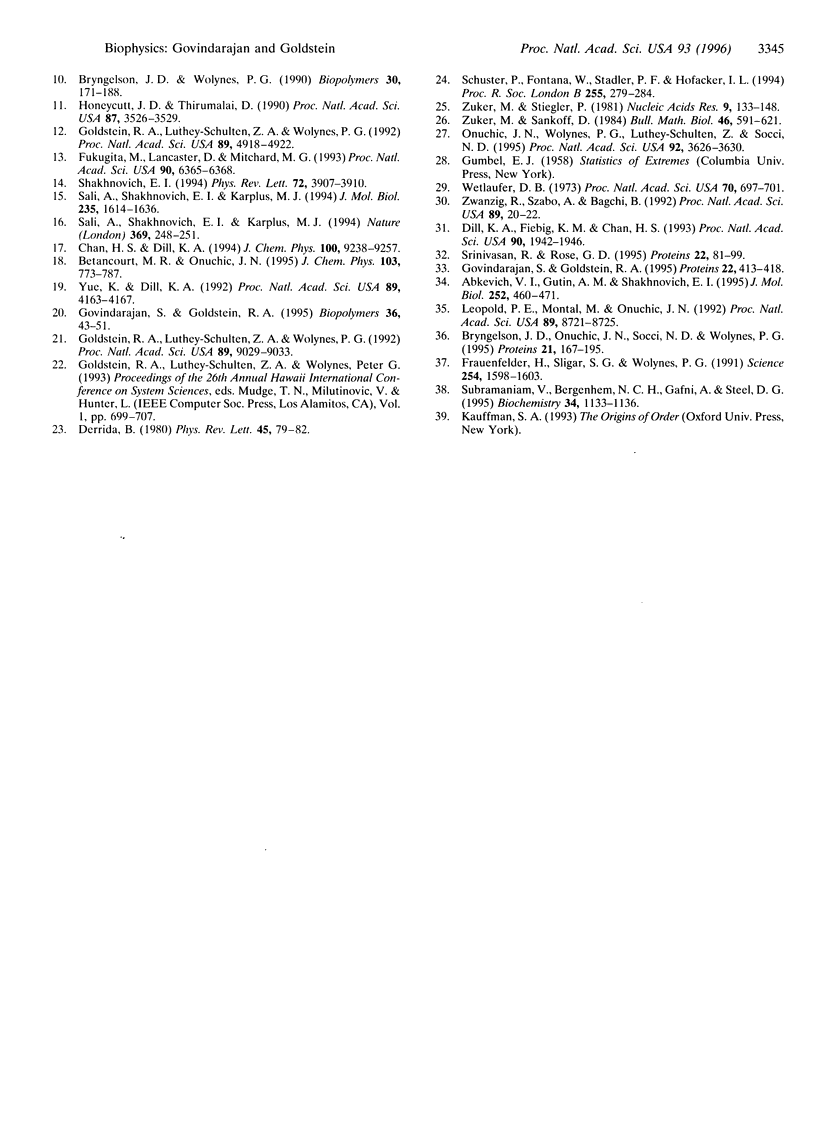
Selected References
These references are in PubMed. This may not be the complete list of references from this article.
- Abkevich V. I., Gutin A. M., Shakhnovich E. I. Impact of local and non-local interactions on thermodynamics and kinetics of protein folding. J Mol Biol. 1995 Sep 29;252(4):460–471. doi: 10.1006/jmbi.1995.0511. [DOI] [PubMed] [Google Scholar]
- Bryngelson J. D., Onuchic J. N., Socci N. D., Wolynes P. G. Funnels, pathways, and the energy landscape of protein folding: a synthesis. Proteins. 1995 Mar;21(3):167–195. doi: 10.1002/prot.340210302. [DOI] [PubMed] [Google Scholar]
- Bryngelson J. D., Wolynes P. G. Spin glasses and the statistical mechanics of protein folding. Proc Natl Acad Sci U S A. 1987 Nov;84(21):7524–7528. doi: 10.1073/pnas.84.21.7524. [DOI] [PMC free article] [PubMed] [Google Scholar]
- Davidson A. R., Sauer R. T. Folded proteins occur frequently in libraries of random amino acid sequences. Proc Natl Acad Sci U S A. 1994 Mar 15;91(6):2146–2150. doi: 10.1073/pnas.91.6.2146. [DOI] [PMC free article] [PubMed] [Google Scholar]
- Dill K. A., Fiebig K. M., Chan H. S. Cooperativity in protein-folding kinetics. Proc Natl Acad Sci U S A. 1993 Mar 1;90(5):1942–1946. doi: 10.1073/pnas.90.5.1942. [DOI] [PMC free article] [PubMed] [Google Scholar]
- Finkelstein A. V., Gutin A. M., Badretdinov AYa Boltzmann-like statistics of protein architectures. Origins and consequences. Subcell Biochem. 1995;24:1–26. doi: 10.1007/978-1-4899-1727-0_1. [DOI] [PubMed] [Google Scholar]
- Finkelstein A. V., Gutun A. M., Badretdinov AYa Why are the same protein folds used to perform different functions? FEBS Lett. 1993 Jun 28;325(1-2):23–28. doi: 10.1016/0014-5793(93)81407-q. [DOI] [PubMed] [Google Scholar]
- Finkelstein A. V., Ptitsyn O. B. Why do globular proteins fit the limited set of folding patterns? Prog Biophys Mol Biol. 1987;50(3):171–190. doi: 10.1016/0079-6107(87)90013-7. [DOI] [PubMed] [Google Scholar]
- Frauenfelder H., Sligar S. G., Wolynes P. G. The energy landscapes and motions of proteins. Science. 1991 Dec 13;254(5038):1598–1603. doi: 10.1126/science.1749933. [DOI] [PubMed] [Google Scholar]
- Fukugita M., Lancaster D., Mitchard M. G. Kinematics and thermodynamics of a folding heteropolymer. Proc Natl Acad Sci U S A. 1993 Jul 1;90(13):6365–6368. doi: 10.1073/pnas.90.13.6365. [DOI] [PMC free article] [PubMed] [Google Scholar]
- Goldstein R. A., Luthey-Schulten Z. A., Wolynes P. G. Optimal protein-folding codes from spin-glass theory. Proc Natl Acad Sci U S A. 1992 Jun 1;89(11):4918–4922. doi: 10.1073/pnas.89.11.4918. [DOI] [PMC free article] [PubMed] [Google Scholar]
- Goldstein R. A., Luthey-Schulten Z. A., Wolynes P. G. Protein tertiary structure recognition using optimized Hamiltonians with local interactions. Proc Natl Acad Sci U S A. 1992 Oct 1;89(19):9029–9033. doi: 10.1073/pnas.89.19.9029. [DOI] [PMC free article] [PubMed] [Google Scholar]
- Govindarajan S., Goldstein R. A. Optimal local propensities for model proteins. Proteins. 1995 Aug;22(4):413–418. doi: 10.1002/prot.340220411. [DOI] [PubMed] [Google Scholar]
- Honeycutt J. D., Thirumalai D. Metastability of the folded states of globular proteins. Proc Natl Acad Sci U S A. 1990 May;87(9):3526–3529. doi: 10.1073/pnas.87.9.3526. [DOI] [PMC free article] [PubMed] [Google Scholar]
- Leopold P. E., Montal M., Onuchic J. N. Protein folding funnels: a kinetic approach to the sequence-structure relationship. Proc Natl Acad Sci U S A. 1992 Sep 15;89(18):8721–8725. doi: 10.1073/pnas.89.18.8721. [DOI] [PMC free article] [PubMed] [Google Scholar]
- Onuchic J. N., Wolynes P. G., Luthey-Schulten Z., Socci N. D. Toward an outline of the topography of a realistic protein-folding funnel. Proc Natl Acad Sci U S A. 1995 Apr 11;92(8):3626–3630. doi: 10.1073/pnas.92.8.3626. [DOI] [PMC free article] [PubMed] [Google Scholar]
- Orengo C. A., Jones D. T., Thornton J. M. Protein superfamilies and domain superfolds. Nature. 1994 Dec 15;372(6507):631–634. doi: 10.1038/372631a0. [DOI] [PubMed] [Google Scholar]
- Sali A., Shakhnovich E., Karplus M. How does a protein fold? Nature. 1994 May 19;369(6477):248–251. doi: 10.1038/369248a0. [DOI] [PubMed] [Google Scholar]
- Sali A., Shakhnovich E., Karplus M. Kinetics of protein folding. A lattice model study of the requirements for folding to the native state. J Mol Biol. 1994 Feb 4;235(5):1614–1636. doi: 10.1006/jmbi.1994.1110. [DOI] [PubMed] [Google Scholar]
- Schuster P., Fontana W., Stadler P. F., Hofacker I. L. From sequences to shapes and back: a case study in RNA secondary structures. Proc Biol Sci. 1994 Mar 22;255(1344):279–284. doi: 10.1098/rspb.1994.0040. [DOI] [PubMed] [Google Scholar]
- Shakhnovich EI. Proteins with selected sequences fold into unique native conformation. Phys Rev Lett. 1994 Jun 13;72(24):3907–3910. doi: 10.1103/PhysRevLett.72.3907. [DOI] [PubMed] [Google Scholar]
- Srinivasan R., Rose G. D. LINUS: a hierarchic procedure to predict the fold of a protein. Proteins. 1995 Jun;22(2):81–99. doi: 10.1002/prot.340220202. [DOI] [PubMed] [Google Scholar]
- Subramaniam V., Bergenhem N. C., Gafni A., Steel D. G. Phosphorescence reveals a continued slow annealing of the protein core following reactivation of Escherichia coli alkaline phosphatase. Biochemistry. 1995 Jan 31;34(4):1133–1136. doi: 10.1021/bi00004a005. [DOI] [PubMed] [Google Scholar]
- Wetlaufer D. B. Nucleation, rapid folding, and globular intrachain regions in proteins. Proc Natl Acad Sci U S A. 1973 Mar;70(3):697–701. doi: 10.1073/pnas.70.3.697. [DOI] [PMC free article] [PubMed] [Google Scholar]
- Yue K., Dill K. A. Inverse protein folding problem: designing polymer sequences. Proc Natl Acad Sci U S A. 1992 May 1;89(9):4163–4167. doi: 10.1073/pnas.89.9.4163. [DOI] [PMC free article] [PubMed] [Google Scholar]
- Zuker M., Stiegler P. Optimal computer folding of large RNA sequences using thermodynamics and auxiliary information. Nucleic Acids Res. 1981 Jan 10;9(1):133–148. doi: 10.1093/nar/9.1.133. [DOI] [PMC free article] [PubMed] [Google Scholar]
- Zwanzig R., Szabo A., Bagchi B. Levinthal's paradox. Proc Natl Acad Sci U S A. 1992 Jan 1;89(1):20–22. doi: 10.1073/pnas.89.1.20. [DOI] [PMC free article] [PubMed] [Google Scholar]


